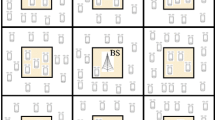Abstract
In this paper, a joint CDMA/TDMA protocol has been proposed for integratedvideo-phone/voice/data traffic in personal communication networks (PCN). Thevideophone service is implemented according to H.261 standard. The concept ofdynamic boundary is adopted in both code and time domains to meet thedifferent requirements for videophone, voice and data traffic.Two mathematical analysis methods are adopted to evaluate the systemperformance. One is the traditional Markov analysis (TDMA), which is used tocalculate the average videophone and voice call blocking probabilities. Theother is Transient Fluid Analysis (TFA), which is adopted to evaluate the datadelay and channel utilization performance. Results show that two dynamicboundaries can be adjusted to achieve the optimal system performance, andsuggestions of how to adjust these boundaries are also given.
Similar content being viewed by others
References
A.E. Brand and A.H. Aghvami, “Performance of the Joint CDMA/PRMA Protocol for Mixed Voice/Data Transmission for Third Generation Mobile Communication”, IEEE Journal on Selected Areas in Communication, Vol. 14, No.9, pp. 1698–1706, 1996.
X. Cheng, L. Zhang and K.H. Chong, “Mathematical Models of Call Admission Control Schemes for Integrated Video-Conferencing/Voice Broadband CDMA Communication Systems”, in IEEE ICCS/ISPACS, 96, pp. 1225–1229, 1996.
D.C. Cox, “Personal Communications – A Viewpoint”, IEEE Communications Magazine, Vol. 28, pp. 8–20, 1990.
R. Esmailzadeh, N. Doi, H. Masui and Y. Ohgoshi, “Spread Spectrum Slot Reservation Multiple Access”, in IEEE VTC, 96, pp. 1715–1719, 1996.
P.J. Fleming and H. Xu, “DS/SS CDMA slotted access channel performance analysis”, in IEEE VTC, 94, Vol. 2, pp. 1189–1192, 1994.
V.O.K. Li and X. Qin, “Personal Communication Systems”, in Proceedings of the IEEE, Vol. 83, No.9, pp. 1210–1243, September 1995.
M. Liou, “Overview of the p*64 kbit/s video coding standard, Communications of the ACM, Vol. 34, No.4, pp. 60–63, 1991.
P. Mermelstein, A. Jalali and H. Leib, “Integrated Services on Wireless Multiple Access Networks”, in ICC'93, pp. 863–867, 1993.
S. Nanda, D.J. Goodman and U. Timor, “Performance of PRMA: A Packet Voice Protocol for Cellular Systems”, IEEE Transactions on Vehicular Technology, Vol. 40, No.3, pp. 584–598, 1991.
J.E. Padgett, C.G. Gunther and T. Hattori, “Overview of Wireless Personal Communications”, IEEE Communications Magazine, Vol. 33, pp. 28–41, 1995.
R. Prasad, CDMA for Wireless Personal Communications, Artech House Publishers: Boston, London, 1996.
R. Prasad, J.A.M. Nijhof and H.I. Cakil, “Hybrid TDMA/CDMA Multiple Access Protocol for Multi-Media Communications”, in ICPWC, 96, pp. 123–128, 1996.
D. Raychaudhuri and N.D. Wilson, “ATM-Based Transport Architecture for MultiservicesWireless Personal Communication Networks”, IEEE Journal on Selected Areas in Communication, Vol. 12, No.8, pp. 1401–1414, 1992.
R. Kohno, R. Meidan and L.B. Milstein, “Spread Spectrum Access Methods forWireless Communications”, IEEE Communications Magazine, pp. 58–67, 1995.
M. Soroushnejad and E. Geraniotis, “Multi-Access Strategies for an Integrated Voice/Data CDMA packet Radio Network”, IEEE Transactions on Communications, Vol. 43, Nos.2–4, pp. 934–945, 1995.
N.D. Wilson, R. Ganesh, K. Joseph and D. Raychaudhuri, “Packet CDMA Versus Dynamic TDMA for Multiple Access in an Integrated Voice/Data PCN”, IEEE Journal on Selected Areas in Communication, Vol. 11, No.6, pp. 870–883, 1993.
Author information
Authors and Affiliations
Rights and permissions
About this article
Cite this article
Xie, P., Gunawan, E., Soong, B. et al. A Protocol for Multimedia CDMA Personal Communication Networks. Wireless Personal Communications 14, 275–301 (2000). https://doi.org/10.1023/A:1008992016471
Issue Date:
DOI: https://doi.org/10.1023/A:1008992016471




